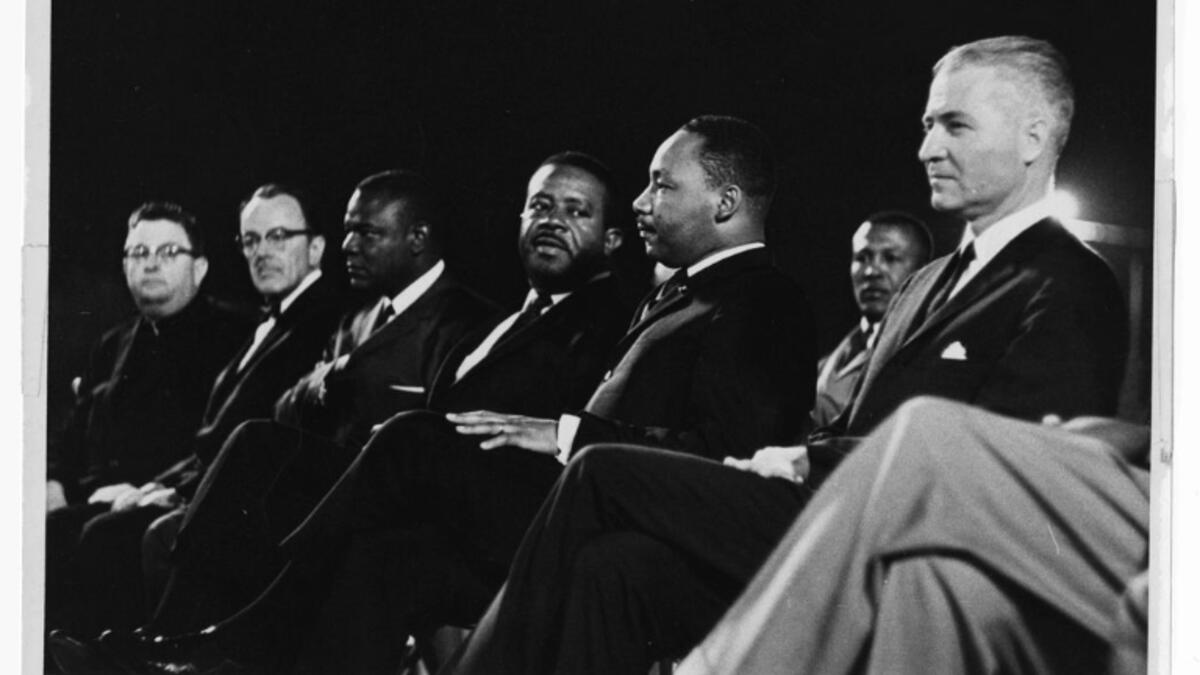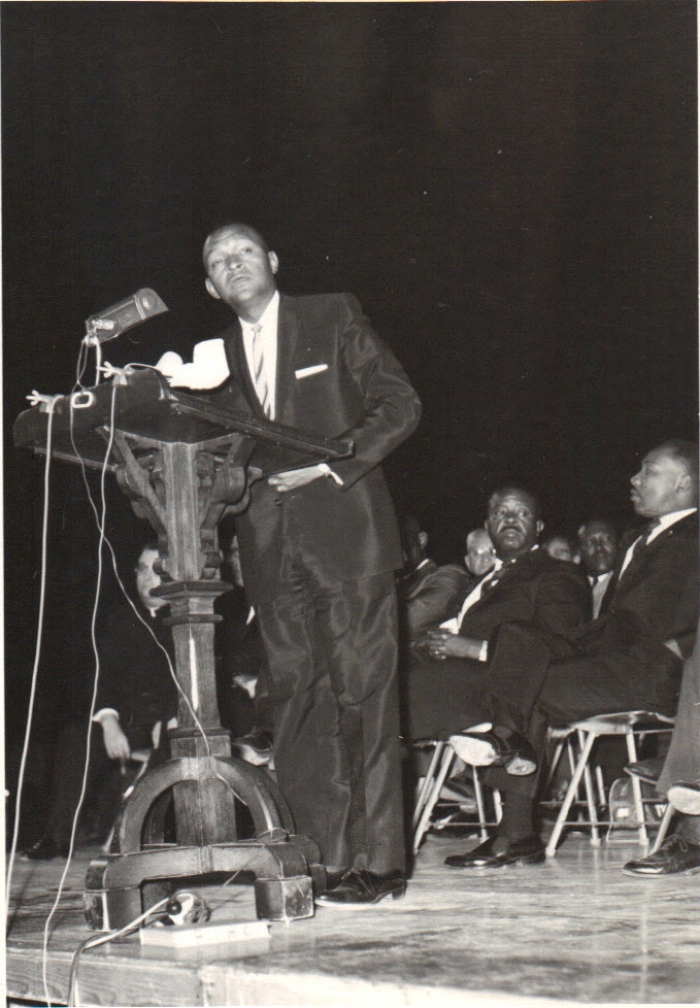MLK's 1964 speech at ASU subject of new, continuing exhibit

Martin Luther King Jr. with community leaders and then-ASU President G. Homer Durham (to King's left) at his speech in Goodwin Stadium in 1964. Photo courtesy ASU archives
On June 3, 1964, Martin Luther King Jr. gave a speech at Goodwin Stadium, then the home of Arizona State University’s football team.
The speech was titled “Religious Witness for Human Dignity” and was delivered just days before the Civil Rights Act was passed by the U.S. Senate.
“The bill must pass,” King said before a crowd of 8,000 people, “and it must pass soon if our nation is to maintain its health.”
King’s speech got lost in the passage of time until 2014, when Phoenix resident Mary Scanlan was shopping at a Goodwill store and found a box of 35 reel-to-reel recordings that had been donated by deceased Phoenix businessman and civil rights leader Lincoln Ragsdale Sr.
One of the tapes was a recording of King’s speech.
Now, 10 years later and on the 60th anniversary of King’s speech, ASU is honoring King’s legacy with a continuing exhibit at Durham Hall.
A groundbreaking for the exhibit will be held at 4 p.m. on Monday, followed by a keynote address from former NBA great Earvin “Magic” Johnson at the Student Pavilion. Following his playing career, Johnson, the chairman and CEO of Magic Johnson Enterprises, has provided products and services primarily for diverse and underserved urban communities.
“The exhibit shows how ASU had a pivotal moment in its history where it brought the religious community, the political community and the civil rights community together in a climate that wasn’t welcoming,” said Mark Brantley, the assistant director of operations for the School of International Letters and Cultures. “Nevertheless, it stood on the frontier of making this happen.”
The exhibit consists of five acrylic panels that will explore themes like segregation in Arizona; King’s visit to ASU; Black faith leaders; the discovery of the speech tapes; and Martin Luther King Jr. Day.
Katy Kole de Peralta, a clinical assistant professor in the School of Historical, Philosophical and Religious Studies, said she’s hopeful the exhibit will shed a light on how pervasive racism was in the United States during King’s lifetime.
“The Civil Rights Movement isn’t just something that just happened in the South,” de Peralta said. “This isn’t just about Montgomery, Alabama. It was a problem here in Phoenix, too. So this is a way to kind of circle back to a message of inclusivity. Just because this story has been left out of the popular narrative doesn’t mean that it’s not important. It doesn’t mean that we shouldn’t kind of return to revitalizing this and understanding the history for what it’s worth.”
Brantley said he got the idea for the exhibit in 2020 while attending an MLK Day celebration at First Institutional Baptist Church in downtown Phoenix. The church’s pastor, Warren Stewart, mentioned that King had visited ASU in the 1960s.
“I was like, ‘Wow, you’ve got to be kidding. I never heard of that,’” Brantley said.
With the help of Shannon Walker, who oversees ASU’s archives, Brantley found a photo of King and others, including then-ASU President Homer Durham, at Goodwin Stadium. He then discovered that the tape of King’s speech had been found at Goodwill.
Later that year, after the death of George Floyd at the hands of a Minneapolis police officer, ASU President Michael Crow asked students, deans and faculty to facilitate initiatives and programs that would protect and defend the rights of individuals.
“When that email went out, I sort of put one and one together and said, ‘Why not highlight the fact that we have a former university president who invited Dr. King to speak?’” Brantley said.
To facilitate the research, Walker reached out to Erin Craft, program coordinator for the School of Historical, Philosophical and Religious Studies. Craft runs a public history undergraduate research experience that includes eight to 10 students every semester. Two students, Catherine Wise and Nicholas West, were hired to do the research, and graduate student Arturo Perez Lopez oversaw their work.
Craft asked the students to tell the story of why King came to ASU, and why his speech was somewhat forgotten.
“This is what historians do,” Craft said. “We pull threads.”
With Craft’s charge in mind, the students researched King’s visit to Tempe, but also discovered broader stories about the Civil Rights Movement in Arizona, including a story about a mother who went back to school after Phoenix schools were desegregated and graduated within a year of her daughter.
“Arizona as a whole is overlooked in the civil rights narrative of this country,” Craft said, “and the students kind of found ways to (show it was a part of it). And the fact that MLK chose to visit Phoenix a month before the civil rights bill was passed is a big deal. He knew that there were things going on in Phoenix that needed to be addressed. The students uncovered just really, really interesting stuff. We were so impressed with their work. They knocked it out of the park.”
In April, Lopez and Wise presented their findings on civil rights pioneers in Phoenix at the National Council for Public History’s annual conference in Salt Lake City.
“I found that the broader narrative of the Civil Rights Movement often overlooks the struggles in the Southwest,” Perez said. “These civil rights pioneers effectively fought against discriminatory, housing, education and employment policies that segregated them from Anglo Phoenix, ushering in a more inclusive era.”
Lopez called his time working on the exhibit a “fantastic experience that enriched me both academically and personally.”
“I gained extensive knowledge about national and local history, particularly about key local figures who played crucial roles in Arizona’s Civil Rights Movement,” he said.
That knowledge even persuaded Lopez to change the topic of his dissertation, from the Black Panther Party to the Civil Rights Movement in Arizona and, in particular, south central Phoenix.
“Working on a project of this magnitude contributed to my professional development and provided me valuable experience in team collaboration,” Lopez said. “Overall, it was an incredible experience.”
More Arts, humanities and education

Local traffic boxes get a colorful makeover
A team of Arizona State University students recently helped transform bland, beige traffic boxes in Chandler into colorful works of public art. “It’s amazing,” said ASU student Sarai…

2 ASU professors, alumnus named 2025 Guggenheim Fellows
Two Arizona State University professors and a university alumnus have been named 2025 Guggenheim Fellows.Regents Professor Sir Jonathan Bate, English Professor of Practice Larissa Fasthorse and…

No argument: ASU-led project improves high school students' writing skills
Students in the freshman English class at Phoenix Trevor G. Browne High School often pop the question to teacher Rocio Rivas.No, not that one.This one:“How is this going to help me?”When Rivas…


